Grazing rights is the right of a user to allow their livestock to feed (graze) in a given area.
Contents



Grazing rights is the right of a user to allow their livestock to feed (graze) in a given area.



Grazing rights have never been codified in United States law, because such common-law rights derive from the English concept of the commons, a piece of land over which people, often neighboring landowners, could exercise one of a number of such traditional rights, including livestock grazing. [1] Prior to the 19th century, the traditional practice of grazing the open range in the United States was rarely disputed because of the sheer amount of unsettled open land. However, as the population of the western United States increased in the mid-to-late 19th century, range wars often erupted over the ranchers' perceived rights to graze their cattle as the western range deteriorated with overuse. [2]
In 1934, the Taylor Grazing Act formally set out the federal government's powers and policy on grazing federal lands in the Western United States by establishing the Division of Grazing and procedures for issuing permits to graze federal lands for a fixed period of time. The Division of Grazing was renamed the US Grazing Service in 1939 and then merged in 1946 with the General Land Office to become the Bureau of Land Management, which along with the United States Forest Service oversees public lands grazing in 16 western states today. [3] However, grazing was never established as a legal right in the U.S., [4] and the Taylor Grazing Act authorized only the permitted use of lands designated as available for livestock grazing while specifying that grazing permits "convey no right, title, or interest" to such lands. [5] Although the regulations stipulated by the Taylor Grazing Act apply only to grazing on Bureau of Land Management lands, the Chief of the Forest Service is authorized to permit or suspend grazing on Forest Service administered property, and many Forest Service grazing regulations resemble those of the Taylor Grazing Act. [6]
In Dalmatia, a historical region of Croatia, judgments about grazing rights are a fundamental part of the jurisprudence. The oldest court verdict in Dalmatia in a court case about grazing rights dates from the 14th century. It is a usufruct of property, which belongs to someone else, or it is a use of a property. Use of someone else's property requires a contract (written or not) about the usufruct. The court may declare parts of the contract as unlawful.
If there is no contract, common law (also called case law) comes to apply. The decisions on who was allowed to judge on grazing rights cases were different in the Middle Ages, which reasoned in tradition and in the natural resources in each area, such as water, meadows, lawns and others. Some peasants wrote their own statute, like Poljica republic in 1440. Also, some dukes wrote together with some peasants their own statute, like Law codex of Vinodol from 1288. [7]

In the United States, national forest is a classification of protected and managed federal lands that are largely forest and woodland areas. They are owned collectively by the American people through the federal government and managed by the United States Forest Service, a division of the United States Department of Agriculture. The U.S. Forest Service is also a forestry research organization which provides financial assistance to state and local forestry industry. There are 154 national forests in the United States.
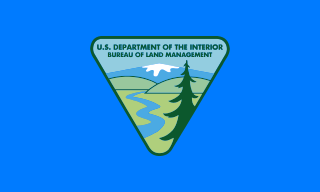
The Bureau of Land Management (BLM) is an agency within the United States Department of the Interior responsible for administering federal lands. Headquartered in Washington, D.C., and with oversight over 247.3 million acres (1,001,000 km2), it governs one eighth of the country's landmass.
In all modern states, a portion of land is held by central or local governments. This is called public land, state land, or Crown land. The system of tenure of public land, and the terminology used, varies between countries. The following examples illustrate some of the range.
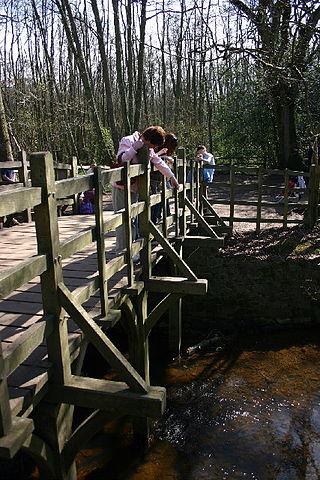
Common land is land owned by a person or collectively by a number of persons, over which other persons have certain common rights, such as to allow their livestock to graze upon it, to collect wood, or to cut turf for fuel.

The Sagebrush Rebellion was a movement in the Western United States in the 1970s and the 1980s that sought major changes to federal land control, use, and disposal policy in 13 western states in which federal land holdings include between 20% and 85% of a state's area. Supporters of the movement wanted more state and local control over the lands, if not outright transfer of them to state and local authorities and/or privatization. As much of the land in question is sagebrush steppe, supporters adopted the name "Sagebrush Rebellion."
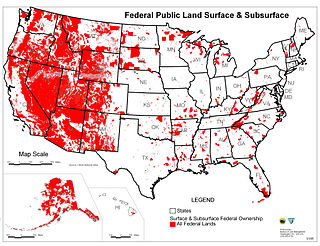
Federal lands are lands in the United States owned by the federal government. Pursuant to the Property Clause of the United States Constitution, Congress has the power to retain, buy, sell, and regulate federal lands, such as by limiting cattle grazing on them. These powers have been recognized in a long line of United States Supreme Court decisions.

The Taylor Grazing Act of 1934 is a United States federal law that provides for the regulation of grazing on the public lands to improve rangeland conditions and regulate their use.
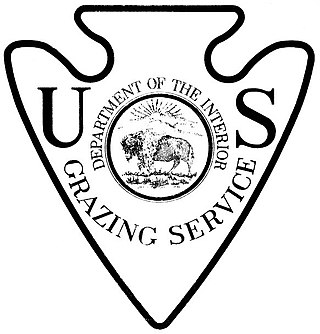
The United States Grazing Service (USGS) was established in 1934 as part of the Taylor Grazing Act. This act was designed to control the destruction of public land due to overgrazing, which had become a problem across western states like Colorado, Wyoming and Montana. The USGS oversees grazing on these lands and regulates the amount of livestock that can be grazed to ensure that the land remains healthy and productive. The USGS also serves as an advocate for ranchers, helping them access permits, utilize water rights, comply with local regulations, and even negotiate grazing leases on public lands.
Revised Statute 2477, commonly known as RS 2477 was enacted by the United States Congress in 1866 to encourage the settlement of the Western United States by the development of a system of highways. Its entire text is one sentence: "the right-of-way for the construction of highways across public lands not otherwise reserved for public purposes is hereby granted."
Kleppe v. New Mexico, 426 U.S. 529 (1976), was a United States Supreme Court decision that unanimously held the Wild and Free-Roaming Horses and Burros Act of 1971, passed in 1971 by the United States Congress to protect these animals from "capture, branding, harassment, or death", to be a constitutional exercise of congressional power. In February 1974, the New Mexico Livestock Board rounded up and sold 19 unbranded burros from Bureau of Land Management (BLM) land. When the BLM demanded the animals' return, the state filed suit claiming that the Wild Free-Roaming Horses and Burros Act was unconstitutional, claiming the federal government did not have the power to control animals in federal lands unless they were items in interstate commerce or causing damage to the public lands.
A grazing fee is a charge, usually on a monthly basis, for grazing a specific kind of livestock.
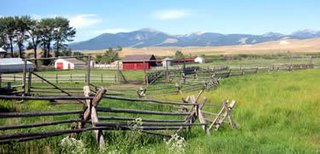
A ranch is an area of land, including various structures, given primarily to ranching, the practice of raising grazing livestock such as cattle and sheep. It is a subtype of farm. These terms are most often applied to livestock-raising operations in Mexico, the Western United States and Western Canada, though there are ranches in other areas. People who own or operate a ranch are called ranchers, cattlemen, or stockgrowers. Ranching is also a method used to raise less common livestock such as horses, elk, American bison, ostrich, emu, and alpaca.

American Prairie is a prairie-based nature reserve in Central Montana, United States, on a mixed grass prairie ecosystem with migration corridors and native wildlife. This wildlife conservation area is being developed as a private project of the American Prairie Foundation (APF). This independent non-profit organization aims to include over 3 million acres (12,000 km2) through a combination of both private and public lands.
The Pryor Mountains Wild Horse Range is a refuge for a historically significant herd of free-roaming mustangs, the Pryor Mountain mustang, feral horses colloquially called "wild horses", located in the Pryor Mountains of Montana and Wyoming in the United States. The range has an area of 39,650 acres (160.5 km2) and was established in 1968 along the Montana–Wyoming border as the first protected refuge dedicated exclusively for mustangs. It was the second feral horse refuge in the United States. About a quarter of the refuge lies within the Bighorn Canyon National Recreation Area. A group of federal agencies, led by the Bureau of Land Management, administers the range.

The Wild and Free-Roaming Horses and Burros Act of 1971 (WFRHBA), is an Act of Congress, signed into law by President Richard M. Nixon on December 18, 1971. The act covered the management, protection and study of "unbranded and unclaimed horses and burros on public lands in the United States."
United States v. Grimaud, 220 U.S. 506 (1911), was a case argued before the Supreme Court of the United States. The case tested the constitutionality of the Forest Reserve Act of 1891, which delegated the power to make rules and regulations regarding the use of federal Forest Service lands and to punish violations of these rules as a criminal offense to the Secretary of the U.S. Department of Agriculture. The Court ruled, after a re-argument, that such a delegation of rulemaking power was permissible because it was separate from true legislative power.

In the Western United States and Canada, open range is rangeland where cattle roam freely regardless of land ownership. Where there are "open range" laws, those wanting to keep animals off their property must erect a fence to keep animals out; this applies to public roads as well. Land in open range that is designated as part of a "herd district" reverses liabilities, requiring an animal's owner to fence it in or otherwise keep it on the person's own property. Most eastern states and jurisdictions in Canada require owners to fence in or herd their livestock.

Management of free-roaming feral and semi-feral horses, on various public or tribal lands in North America is accomplished under the authority of law, either by the government of jurisdiction or efforts of private groups. In western Canada, management is a provincial matter, with several associations and societies helping to manage wild horses in British Columbia and Alberta. In Nova Scotia, and various locations in the United States, management is under the jurisdiction of various federal agencies. The largest population of free-roaming horses is found in the Western United States. Here, most of them are protected under the Wild and Free-Roaming Horses and Burros Act of 1971 (WFRH&BA), and their management is primarily undertaken by the Bureau of Land Management (BLM), but also by the U. S. Forest Service (USFS)
The 2014 Bundy standoff was an armed confrontation between supporters of cattle rancher Cliven Bundy and law enforcement following a 21-year legal dispute in which the United States Bureau of Land Management (BLM) obtained court orders directing Bundy to pay over $1 million in withheld grazing fees for Bundy's use of federally owned land adjacent to Bundy's ranch in southeastern Nevada.
Grazing rights in Nevada covers a number of rangeland Federal and state laws and regulations applicable to the state of Nevada. Rangelands are distinguished from pasture lands because they grow primarily native vegetation, rather than plants established by humans. Ranchers may lease or obtain permits to use portions of this public rangeland and pay a fee based on the number and type of livestock and the period for which they are on the land.